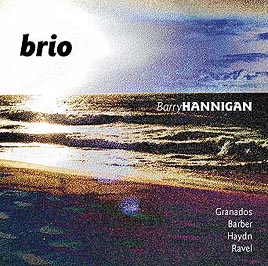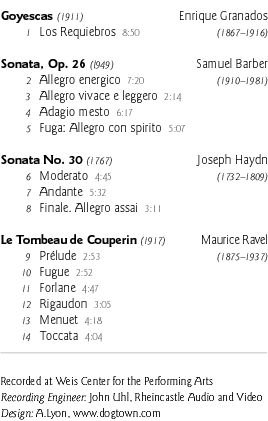

Listen to music from this CD.
Order this CD.
|
|
Listen to music from this CD.
Order this CD.
Liner Notes
Enrique Granados is known as both pianist and composer. Upon graduation from conservatories in Barcelona and Madrid, he was successful in establishing a reputation as a pianist, eventually inaugurating his own piano school, the Academia Granados, in l901. Goyescas (1911) owes its origin to Granados’s admiration for the etchings and paintings of Goya. The pieces are extremely effective, and they are certainly among the most important piano works by a Spanish composer.
In Los Requiebros (Flattery), the composition hinges on the embellishment of two melodic ideas that are heard in the first few pages of the work. Granados brilliantly reworks this material in a through-composed manner, ornamenting the melodies and altering the harmonies and accompaniments. The writing is so fluid and pianistic that the work seems improvisational.
Granados expanded Goyescas into an opera. The premiere was scheduled for New York in l916. Granados and his wife made the voyage to attend, but on the return to Europe, a German submarine torpedoed the British ship S.S. Sussex, and the couple died at sea.
Samuel Barber’s Sonata (1949) is one of the most well-known American piano pieces of the twentieth-century. Its success lies in Barber’s extraordinary craftsmanship and in the exceptionally wide range of emotional and musical ideas that fill its pages. The moods range from the utmost delicacy and mournfulness to raging virtuosity.
Vladimir Horowitz premiered the work in New York in l950. It is a full-scale sonata in four movements. The form of each movement is very traditional: sonata, rondo, ABA, and fugue. The first movement, marked Allegro energico, is a standard sonata form, complete with two contrasting themes and a motivic development section—the only unusual feature is the high level of dissonance. Occasional passages remind the listener of the pervasive influence of Arnold Schoenberg on the composers of our century—even such a conservative composer as Barber. The reference is unmistakable, however, since Barber arranges obvious sequences of twelve chromatic notes into a melodic flourish at the end of the first movement, and into the chords that accompany the melody at the opening of the third movement. The last movement is an intricate fugue in four voices, crafted brilliantly enough to satisfy even J.S. Bach. Barber utilizes a complete range of fugal techniques, including stretto, inversion, and augmentation. Every note of the movement is drawn from the subject in one way or another, and even the fast-moving accompaniments are fashioned from the contour of the theme. Barber effectively traverses the entire keyboard as he works with his subject, concluding the movement with a powerful climax.
Joseph Haydn’s Sonata in D Major (CL No. 30, probably composed l767) is a lovely short sonata in three movements. The first movement, Moderato, is notable for the contrast of its themes. The dotted rhythms and strong character of the opening melody readily offset the lyricism of the florid melodic line that follows. The development, in typical Haydn fashion, is marked by a variety of short patterns that repeat in different keys, eventually building to a climax just before the principal melody returns. The second movement is in two parts, the second of which is a variation of the first. Haydn recalls the first movement by reintroducing the dotted rhythm of the opening. A striking feature of the movement is the extensive use of the baritone register for the beautiful melody, almost as if Haydn were writing a movement for viola da gamba instead of piano. The third movement is simplicity itself, a sequence of short binary forms fashioned into a rondo (a binary form is two short passages of music, each of which is repeated). The opening binary returns three times, varied slightly each time, though never leaving the primary key of D major. Haydn provides contrast in the two episodes, a section in D minor/F major (at 0:24) and another binary in A major (at 1:30) whose most distinguishing feature is repeated octaves in the bass.
Maurice Ravel composed Le Tombeau de Couperin during the years 1914–17. He spent 1914–16 on a tour of duty in WWI as an ambulance driver, but was forced to quit the army when his health gave way. He dedicated each movement of the composition to a friend who had died in the war. Given such a background, it is surprising that the works are so crystalline and emotionally restrained—the only movement that betrays the origin of the dedications is his Menuet, which contains a hint of an elegy.
Ravel found inspiration for the work in the 18th-century (preclassical) form of the suite. He stated that the piece “is a tribute not so much to Couperin himself as to 18th-century French music in general.” The ornamentation of the work—found in the Prelude, Forlane, Rigaudon, and Menuet—is a direct throwback to the harpsichord writing of the earlier century. The most unusual movement is Ravel’s Forlane, a recreation of a northern Italian dance in triple meter. It is marked by extraordinary harmonies and Ravel’s persistent use of the rhythm of a sicilienne. The other movements are each remarkable in their own way. The Prelude has elegant passagework in which Ravel displays his compositional inventiveness by repeating short melodies multiple times until they create soaring, long phrases. The Fugue has an exceptionally compact nature, for the three voices are often compressed into the range of an octave. The concluding Toccata, famous among pianists for its difficulty, is a showcase of fast-moving chords and glittering repeated notes. |